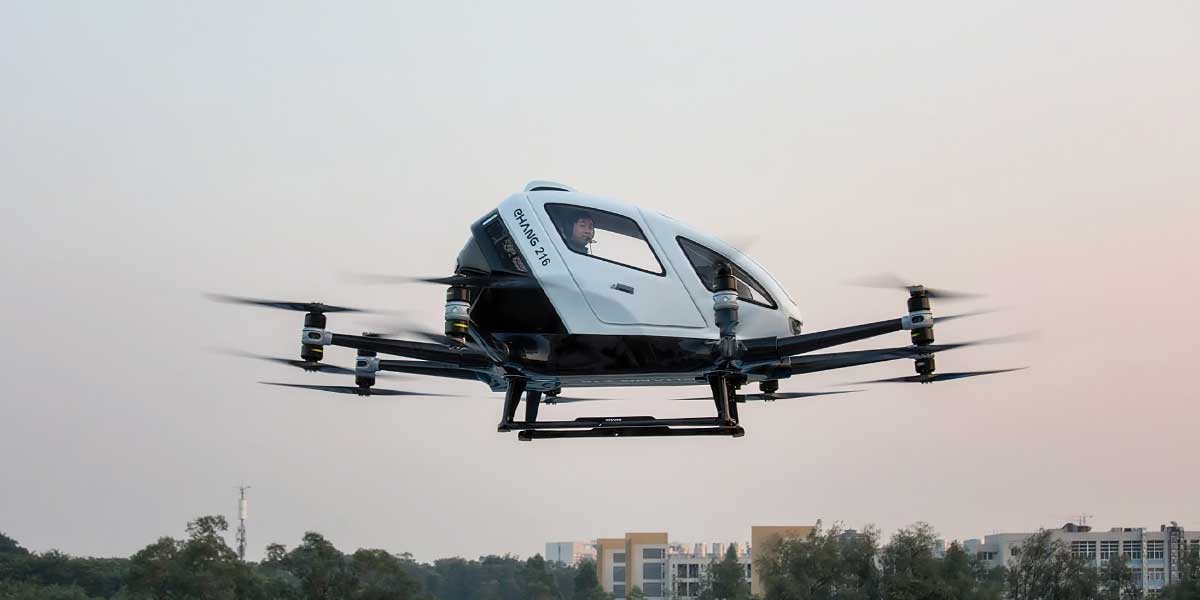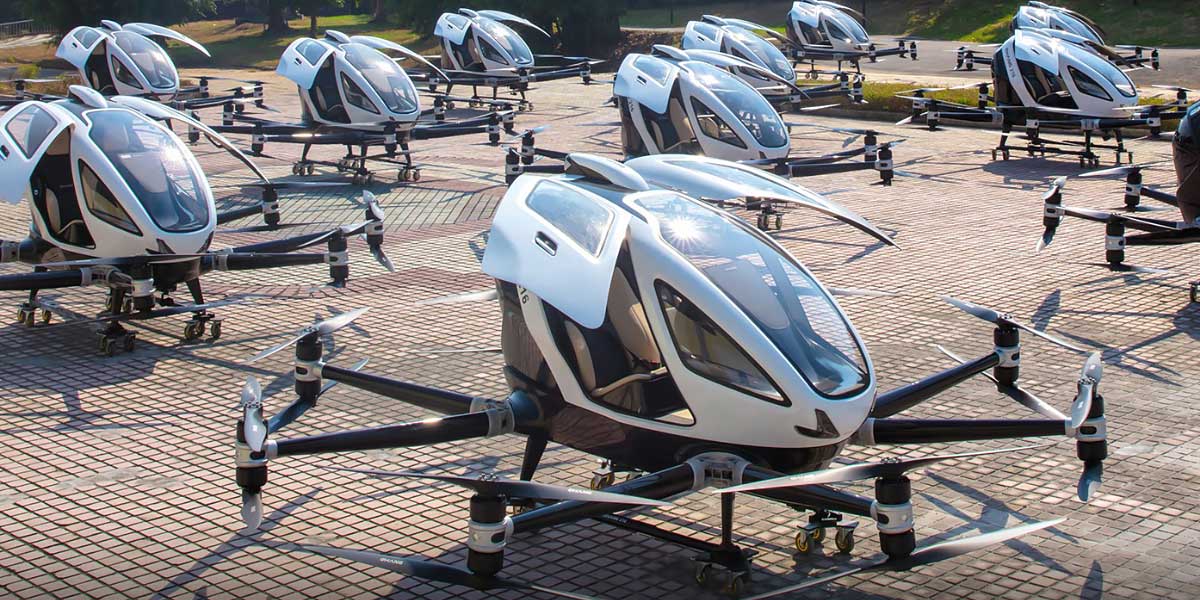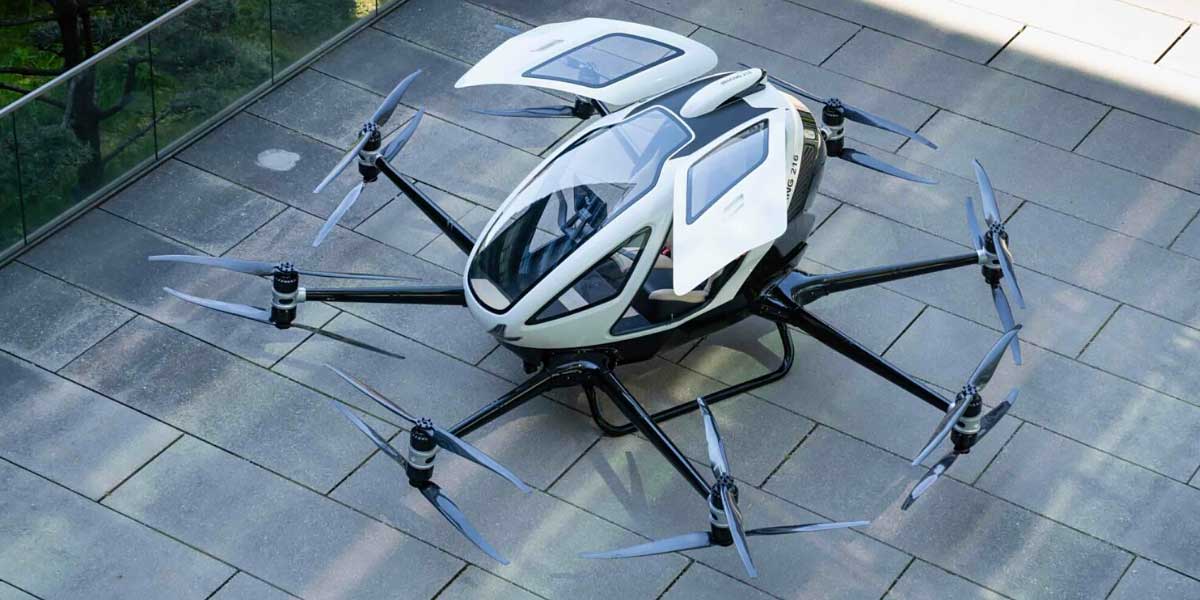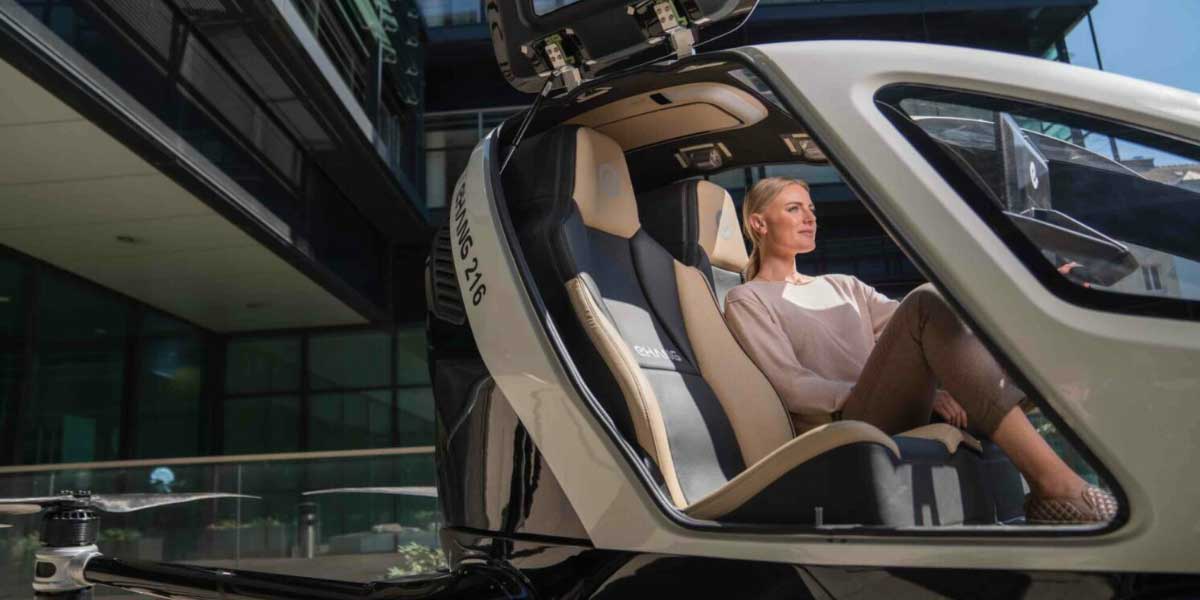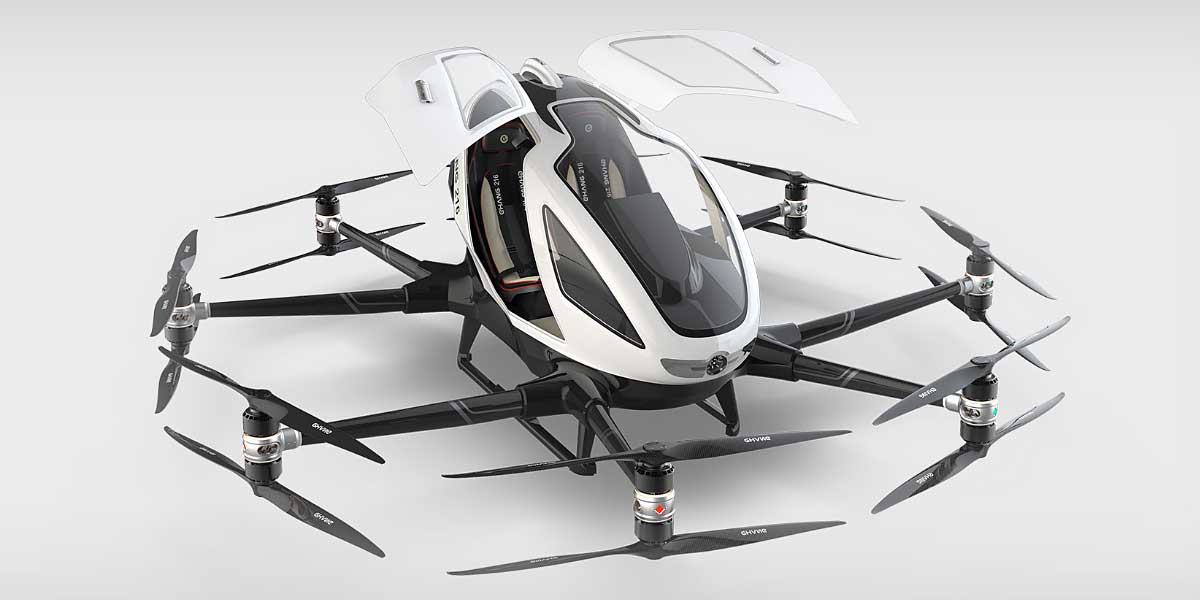EHang 216 AAV
User Rating: 4.90 / 5





What is the EHang 216 AAV?
EHang 216 AAV is a cutting-edge autonomous aerial vehicle designed for urban air mobility. This two-seater drone can carry passengers autonomously, offering a unique solution for efficient transport. With a top speed of 80 mph and a flight time of up to 25 minutes, it blends innovation with practicality.
EHang 216 AAV price:
US$ 410000 *
| manufactured in | China |
| model year | 2024 |
| flight altitude (m) | 3000 |
| flying time (min) | 21 |
| flying range (km) | 35 |
| max. speed (km/h) | 130 |
| weight (kg) | 360 |
| passengers (qty) | 2 |
| cargo capacity (kg) | 220 |
* Minimum price set by the manufacturer, excluding taxes and additional options
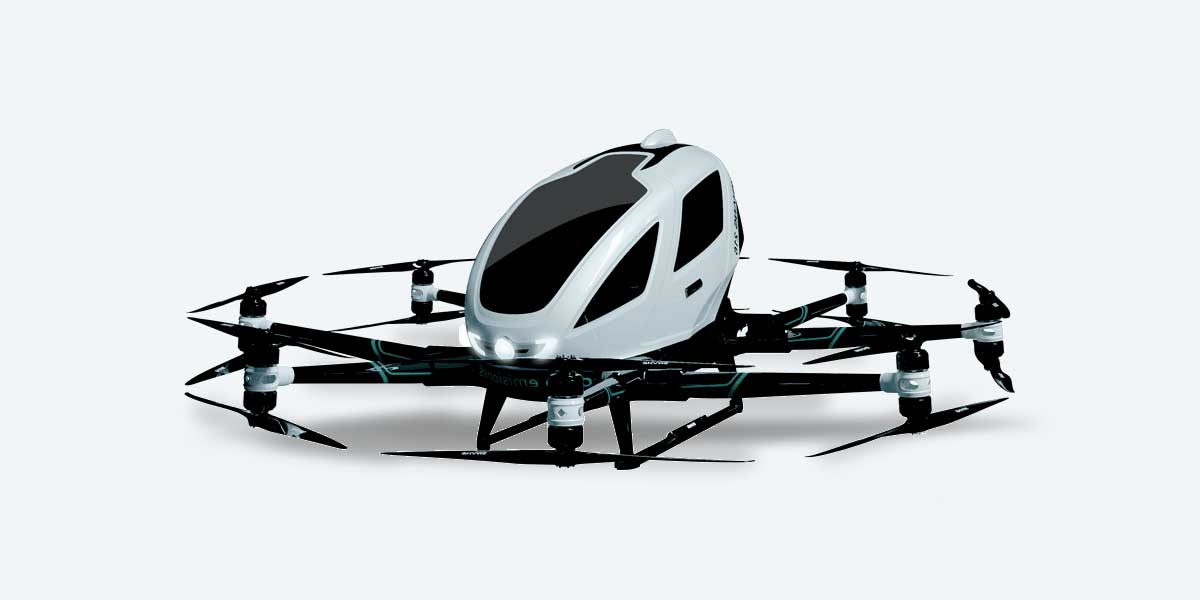
Exterior and Interior photos of EHang 216 AAV
EHang 216 AAV Review
EHang 216 Autonomous Aerial Vehicle: The Future of Urban Skyways
With a price tag of around $410,000, ready to launch in 2024, the EHang 216 Autonomous Aerial Vehicle (AAV) hails from the innovative workshops of China. It stands as a bold pioneer in urban air mobility. Sporting features like a cruising altitude of 3,000 meters, 21 minutes of airtime, a journey span of 35 kilometers, and a top speed of 130 km/h, this aerial marvel edges closer to redefining urban commuting for its two passengers, merging ecological awareness with the exhilaration of flight.
EHang 216's Aesthetic Declaration: Where Design Meets Future
The EHang 216 is more than a transportation mode; it's a statement of the future. Its form, evoking messages from the days ahead, adorned with 16 spinning rotors, whispers of a time when urban air travel entwines sleek aerodynamics with stylish flair.
Technical Bravura Underpinning the EHang 216 AAV
Under its futuristic exterior, the EHang 216 conceals a sophisticated network of technological marvels. Powered by an all-electric motor, it transports passengers, free from human pilots, with autonomy that choreographs a dance of precision and safety. Here, innovation isn't just layered; it’s a credo that makes the journey not just possible but harmonious.
Charting the Course for Greener Horizons
In an age marked by rising eco-consciousness, the EHang 216 AAV stands as a guardian of the environment. Its electric heart soars through the skies, leaving no carbon footprint, heralding the dawn of cleaner, greener urban skylines.
The Quintessence of the EHang 216 Sojourn
The allure of the EHang 216 goes beyond mere transportation; it signifies an elevation in experience. To be within its embrace is to embark on a journey not just between points but across new dimensions, transforming the mundane commute into a thrilling autonomous adventure. The voyage within the 216 is enveloped in serenity, far removed from the terrestrial turmoil of regular travel.
The Advent of Skyborne Novelty: The Creed of EHang
The EHang 216 doesn't merely mark an achievement; it makes a bold declaration in the narrative of human craftsmanship. With each rotor's turn, it propels us toward an era where the sky becomes a well-trodden path—where the limits of possibility are redrawn. EHang offers not just a means of transport but an odyssey, an invitation to partake in the aerial spectacle of tomorrow's journey, today.
From its visual allure to its sustainable essence, the EHang 216 embodies the spirit of progress. This machine isn’t just an extension of urban transportation; it heralds the beginning of a purer, more vibrant adventure through the skies. Step aboard the EHang 216, and witness a journey where the destination is as spectacular as the travel itself.
Manufacturer: Ehang
Related Video
Comparison:
Charging Speed and Power Output
The EHang 216 AAV touts an 8-blade grand spectacle that draws power like a Hollywood blockbuster—charging at an impressive rate befitting its aerial ambitions. Compare that to the Volocopter 2X, which takes a timid approach with slightly longer charging times, proving its more a practical air taxi than a speed demon. Now, let’s take a peek at the Airbus Vahana; its auto-docking recharge mechanism is a stroke of ingenuity, yet it still cant outpace the rapid load-ups of the EHang. Lastly, the Joby S4 is the tortoise in this race—steady but slower in the charging marathon.
Connector Types and Compatibility
The EHang 216 AAV brags connecting options as flexible as a contortionist, compatible with both DC fast chargers and a fleet of AC options. Try rivaling that, and you’re up against the somewhat stodgy Volocopter 2X that sticks to its proprietary connectors—good luck finding those in your garage. The Airbus Vahana offers a smidgen more compatibility yet still trails behind the EHang. Joby S4, while infinitely innovative, remains exclusive in its connector tech, leaving you pining for universal adaptors.
Cost and Pricing Models
Wallets, brace yourselves. At a price tag of $410,000, £299,000, or €345,000, the EHang 216 AAV is more investment than impulse buy. In comparison, the Volocopter 2X delivers a less eye-watering experience at approximately $350,000. The Airbus Vahana? Prepare to mortgage not just your house but possibly your soul, fetching around $450,000. The Joby S4 sits snugly in between these figures at $400,000—a value befitting its middle-weight stature.
Availability and Accessibility
Jumping onto an EHang 216 AAV is surprisingly convenient; its setting up shop in numerous city skylines. Volocopter 2X is more elusive, primarily fluttering around European tech hubs. The Airbus Vahana exists more conceptually than physically, with availability still in its nascent stages. Finally, the illustrious Joby S4 seems poised for an elite few, still battling regulatory hurdles for widespread deployment.
Charging Station Features
The EHang 216 AAV doesn’t just fly; it flaunts. Its charging stations come with automated systems and advanced diagnostics to keep your air beast in prime shape. Contrarily, the Volocopter 2X offers simpler stations with fewer frills. The Airbus Vahana impresses with automated docking but lacks the advanced diagnostic maneuvers. Joby S4? Think iPhone charger—tantalizingly sleek but not particularly feature-rich.
Price
Setting you back by $410,000, £299,000, or €345,000, the EHang 216 AAV runs parallel to high-end luxury marques. If you’re more financially conservative, the Volocopter 2X offers similar aerial splendor for $350,000, £255,000, or €295,000. Go for the gold standard with the Airbus Vahana, but beware of its $450,000, £330,000, or €380,000 ticket. For the discerning connoisseur, the Joby S4 sits at a balanced $400,000, £290,000, or €335,000.
Lets face it, the EHang 216 AAV thrusts you into the future with the pizzazz and practicality that makes it a heavyweight contender in the Electric Flying EV class. Whether youre a tech maven or an everyday consumer, its hard to say no to gliding above the daily grind.F.A.Q.:
How long does the battery last on a full charge?
The EHang 216 AAV typically has a flight duration of around 20-23 minutes on a full charge, depending on various factors such as payload and weather conditions.
What is the battery capacity and how long does it take to charge?
The EHang 216 AAV features a battery capacity of approximately 17 kWh. It usually takes about 2 hours to fully charge the battery.
What is the initial purchase price of the EHang 216 AAV?
The initial purchase price of the EHang 216 AAV is around $410,000 USD, which converts to approximately €389,000 EUR or £354,000 GBP based on current exchange rates.
What is the top speed of the EHang 216 AAV?
The top speed of the EHang 216 AAV is about 130 km/h (approximately 81 mph).
How many passengers can the EHang 216 AAV accommodate?
The EHang 216 AAV can accommodate up to 2 passengers with a maximum payload capacity of around 260 kg (approximately 573 lbs).
What materials are used in the construction of the EHang 216 AAV?
The EHang 216 AAV is primarily constructed using lightweight and durable materials such as carbon fiber, which ensures both strength and energy efficiency.
What additional features are available?
The EHang 216 AAV includes advanced features such as autonomous flight capability, redundant systems for enhanced safety, and a sophisticated interactive cockpit interface.
How does it perform on different terrains?
The EHang 216 AAV is designed for urban air mobility, performing efficiently in both cityscapes and suburban areas, eliminating terrain restrictions that ground vehicles might experience.

